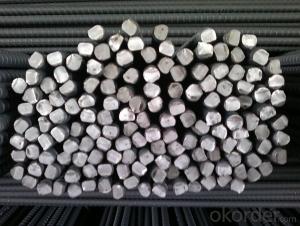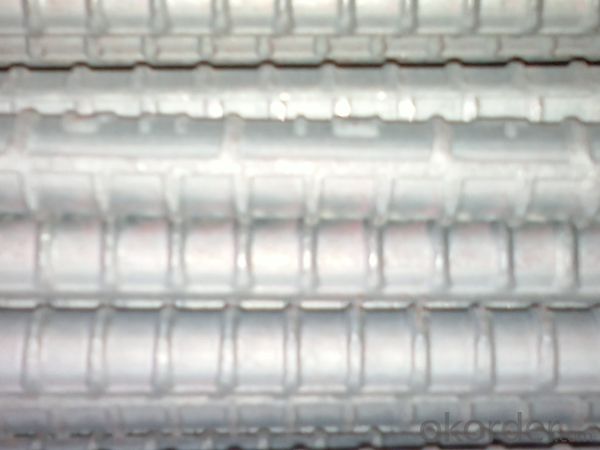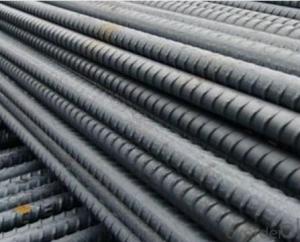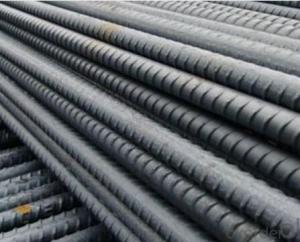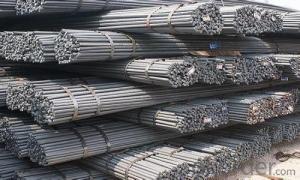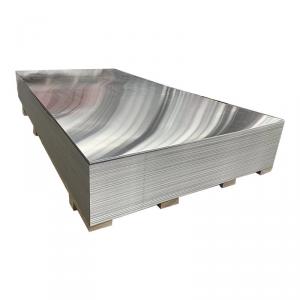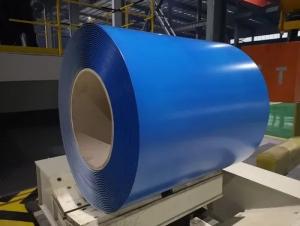Reinforced With Steel Hot Rolled GB Standard Deformed Steel Rebars for Construction
- Loading Port:
- Tianjin
- Payment Terms:
- TT OR LC
- Min Order Qty:
- 25 m.t.
- Supply Capability:
- 200000 m.t./month
OKorder Service Pledge
OKorder Financial Service
You Might Also Like
Product Description:
OKorder is offering Hot Rolled GB Standard Deformed Steel Rebars for Construction at great prices with worldwide shipping. Our supplier is a world-class manufacturer of steel, with our products utilized the world over. OKorder annually supplies products to European, North American and Asian markets. We provide quotations within 24 hours of receiving an inquiry and guarantee competitive prices.
Product Applications:
Hot Rolled GB Standard Deformed Steel Rebars for Construction are ideal for structural applications and are widely used in the construction of buildings and bridges, and the manufacturing, petrochemical, and transportation industries.
1. Supporting members, most commonly in the house raising industry to strengthen timber bears under houses. Transmission line towers, etc
2. Prefabricated structure
3. Medium scale bridges
4. It is widely used in various building structures and engineering structures such as roof beams, bridges, transmission towers, hoisting machinery and transport machinery, ships, industrial furnaces, reaction tower, container frame and warehouse etc.
Product Advantages:
Hot Rolled GB Standard Deformed Steel Rebars for Construction are durable, strong, and resist corrosion.
Main Product Features:
· Premium quality
· Prompt delivery & seaworthy packing (30 days after receiving deposit)
· Corrosion resistance
· Can be recycled and reused
· Mill test certification
· Professional Service
· Competitive pricing
Product Specifications:
Our supplier is a world-class manufacturer of steel, with our products utilized the world over. OKorder annually supplies products to European, North American and Asian markets. We provide quotations within 24 hours of receiving an inquiry and guarantee competitive prices.
Product Applications:
High Quality Hot Rolled Equal Angle Steel Bars for Strcuture are ideal for structural applications and are widely used in the construction of buildings and bridges, and the manufacturing, petrochemical, and transportation industries.
1. Supporting members, most commonly in the house raising industry to strengthen timber bears under houses. Transmission line towers, etc
2. Prefabricated structure
3. Medium scale bridges
4. It is widely used in various building structures and engineering structures such as roof beams, bridges, transmission towers, hoisting machinery and transport machinery, ships, industrial furnaces, reaction tower, container frame and warehouse etc.
Product Advantages:
High Quality Hot Rolled Equal Angle Steel Bars for Constrcution are durable, strong, and resist corrosion.
Main Product Features:
· Premium quality
· Prompt delivery & seaworthy packing (30 days after receiving deposit)
· Corrosion resistance
· Can be recycled and reused
· Mill test certification
· Professional Service
· Competitive pricing
Product Specifications:
Specifications of Hot Rolled GB Standard Deformed Steel Rebars for Construction:
Standard | GB UK USA | HRB335 HRB400 HRB500 G460B, B500A, B500B,B500C GR40, GR60 | |
Diameter | 6mm,8mm,10mm,12mm,14mm,16mm,18mm,20mm, 22mm,25mm,28mm,32mm,36mm,40mm,50mm | ||
Length | 6M, 9M,12M or as required | ||
Packing | Export standard packing: wrapped by wire rod in bundles | ||
Each bundle weight | 2-3MT, or as required | ||
Trade terms | FOB, CFR, CIF | ||
Payment terms | TT payment in advance or Irrevocable LC at sight. | ||
Delivery Detail | within 45 days after received advanced payment or LC. | ||
Brand name | DRAGON | ||
Theoretical weight and section area of each diameter as below for your information:
Diameter(mm) | Section area (mm²) | Mass(kg/m) | Weight of 12m (kg) | Pcs/ton |
6 | 28.27 | 0.222 | 2.664 | 375.38 |
8 | 50.27 | 0.395 | 4.74 | 210.97 |
10 | 78.54 | 0.617 | 7.404 | 135.06 |
12 | 113.1 | 0.888 | 10.656 | 93.84 |
14 | 153.9 | 1.21 | 14.52 | 68.87 |
16 | 201.1 | 1.58 | 18.96 | 52.74 |
18 | 254.5 | 2.00 | 24 | 41.67 |
20 | 314.2 | 2.47 | 29.64 | 33.74 |
22 | 380.1 | 2.98 | 35.76 | 27.96 |
25 | 490.9 | 3.85 | 46.2 | 21.65 |
28 | 615.8 | 4.83 | 57.96 | 17.25 |
32 | 804.2 | 6.31 | 75.72 | 13.21 |
36 | 1018 | 7.99 | 98.88 | 10.43 |
40 | 1257 | 9.87 | 118.44 | 8.44 |
50 | 1964 | 15.42 | 185.04 | 5.40 |
Chemical Composition: (Please kindly find our chemistry of our material based on JIS as below for your information)
JISG3112 SD390 | Chemical Composition | ||||
C | Mn | Si | S | P | |
0.22 | 1.38 | 0.4 | 0.014 | 0.022 | |
Physical capability | |||||
Yield Strength(N/cm²) | Tensile Strength(N/cm²) | Elongation (%) | |||
620 | ≥400 | 21 | |||
The production process of Steel Rebar

1-Waling beam furnace 2-Roughing rolling group 3-Intermediate rolling train
4-Finishing rolling group 5-Water-cooling device 6-Walking beam cooler
7-Finishing equipment(including the cold scale shear,short feet collection system,
automatic counting device,bundling machine, collect bench)
Usage and Applications of Hot Rolled GB Standard Deformed Steel Rebars for Construction:
Deformed bar is widely used in buildings, bridges, roads and other engineering construction. Big to highways, railways, bridges, culverts, tunnels, public facilities such as flood control, dam, small to housing construction, beam, column, wall and the foundation of the plate, deformed bar is an integral structure material. With the development of world economy and the vigorous development of infrastructure construction, real estate, the demand for deformed bar will be larger and larger..
Packaging & Delivery of Hot Rolled GB Standard Deformed Steel Rebars for Construction:
Packaging Detail: products are packed in bundle and then shipped by container or bulk vessel, deformed bar is usually naked strapping delivery, when storing, please pay attention to moisture proof. The performance of rust will produce adverse effect.
Price: Keep lower operating costs so as to offer competitive price for our clients
Deformed Steel Rebars according to Korean standard
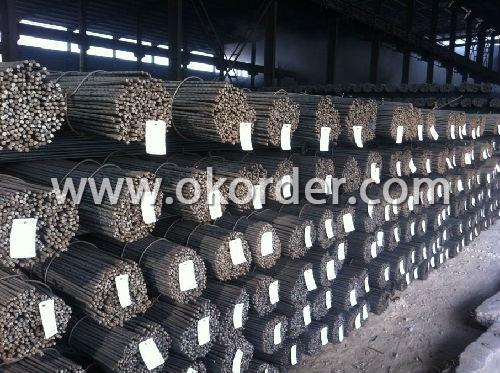

Note:
1. Our products are produced according to national standard (GB), if not, supply according to national standards (GB) or agreement as customer required.
2. Other Grade and Standard Deformed Steel Bar we can supply:
Grade: GR40/GR60, G460B/B500A/B500B/B500C,BST500S
Standard: ASTM, BS, DIN
The Minimum Order Quantity of these products is high, and need to be confirmed.
3. We can not only supply Deformed Steel Bar; if you need anything about building materials, please contact us for further information.
4. Please send us your detail specifications when inquire. We will reply to you as soon as possible. We sincerely hope we can establish a long stable business relationship.
- Q:How are steel rebars used in the construction of tunnels and underground passages?
- Steel rebars are used in the construction of tunnels and underground passages to reinforce the concrete structures. They are embedded within the concrete to increase its strength and prevent cracking or collapsing under the pressure exerted by the surrounding soil or water. The rebars provide structural integrity and durability, ensuring the tunnels and passages can withstand the forces and stresses they encounter.
- Q:What is the impact of steel rebars on the overall carbon footprint of a building?
- The overall carbon footprint of a building is significantly influenced by the presence of steel rebars. This is because the production of steel involves the consumption of high amounts of energy and the release of substantial greenhouse gas emissions, particularly carbon dioxide. The carbon footprint of a building is further affected by activities such as the extraction and processing of iron ore, as well as the manufacturing and transportation of steel rebars. The extent to which steel rebars are used in a building also plays a role in its carbon footprint. The more steel rebars that are utilized, the higher the carbon footprint will be. The quantity of steel rebars required is determined by factors such as the size and complexity of the structure, as well as specific design requirements. However, it is worth noting that steel rebars are an essential component of reinforced concrete, which is widely used in construction due to its strength and durability. Reinforced concrete ensures the structural integrity and longevity of a building, consequently contributing to its safety. While steel rebars contribute to the building's carbon footprint, they also play a critical role in constructing secure and resilient structures. To mitigate the carbon footprint associated with steel rebars, several strategies can be employed. One approach is to utilize recycled steel rebars, which significantly reduces the energy consumption and emissions associated with steel production. Additionally, optimizing the design and construction process can help minimize the overall amount of steel required, thereby reducing the carbon footprint. Furthermore, alternative materials such as fiber-reinforced polymers (FRPs) are being developed as substitutes for steel rebars. FRPs have lower carbon footprints since they are made from materials like fiberglass or carbon fiber, which have lower emissions during production. However, the use of FRPs is still limited, and further research and development are needed to enhance their viability as a mainstream alternative. In conclusion, the presence of steel rebars has a significant impact on the carbon footprint of a building due to the energy-intensive production process and emissions associated with their extraction, manufacturing, and transportation. Nevertheless, their crucial role in providing structural integrity and durability should not be overlooked. Efforts to reduce the carbon footprint of steel rebars include the use of recycled materials, the optimization of designs, and the exploration of alternative materials like FRPs. Ultimately, a comprehensive approach that considers both the environmental impact and the structural requirements of a building is necessary to minimize the carbon footprint associated with steel rebars.
- Q:How do steel rebars contribute to the energy efficiency of a building?
- There are several ways in which steel rebars contribute to the energy efficiency of a building. To begin with, they are used to reinforce concrete structures like beams, columns, and walls. This reinforcement enhances the building's structural integrity, enabling it to withstand different loads and forces. Consequently, the construction process requires fewer materials, resulting in a more energy-efficient building. Moreover, steel rebars possess exceptional thermal conductivity properties. This means they can effectively transfer and distribute heat throughout the building, aiding in regulating the internal temperature. By evenly dispersing heat, steel rebars help to minimize temperature fluctuations, thereby reducing the need for excessive heating or cooling systems and conserving energy. Furthermore, steel rebars have a lengthy lifespan and necessitate minimal upkeep. This durability ensures that the building remains structurally sound over time, decreasing the frequency of repairs or replacements. As a result, the energy consumed in maintenance and renovation activities is significantly reduced. Additionally, the use of steel rebars enables the construction of larger, open spaces with fewer supporting columns. This design flexibility allows for the incorporation of natural light and ventilation, reducing dependence on artificial lighting and air conditioning systems. By maximizing the utilization of natural resources, steel rebars contribute to the energy efficiency of the building. In conclusion, steel rebars play a crucial role in improving the energy efficiency of a building. Their ability to reinforce structures, efficient thermal conductivity, durability, and design flexibility all contribute to decreasing the energy consumption associated with the construction, maintenance, and operation of the building.
- Q:How do steel rebars bond with concrete?
- Steel rebars bond with concrete through a process called mechanical interlock, where the rough surface of the rebar provides better adhesion to the concrete. Additionally, the alkaline environment of the concrete forms a thin layer of iron oxide on the surface of the rebar, which further enhances the bond and prevents corrosion.
- Q:Can steel rebars be used in the construction of residential towers?
- Yes, steel rebars can be used in the construction of residential towers. Steel rebars provide strength and durability to reinforced concrete structures, making them an ideal choice for high-rise buildings like residential towers. They help reinforce the concrete and enhance its load-bearing capacity, ensuring the structural integrity and safety of the construction.
- Q:How do steel rebars contribute to the crack control in slabs and walls?
- Steel rebars contribute to crack control in slabs and walls through their ability to resist tensile forces. When concrete slabs and walls experience loads, such as the weight of the structure or external forces, they may develop tensile stresses. Concrete is strong in compression but weak in tension, making it prone to cracking under tensile forces. Steel rebars are embedded within the concrete to counteract these tensile stresses. By absorbing and distributing the tensile forces, rebars help to prevent crack formation and control their propagation. The rebars act as reinforcement, increasing the overall tensile strength of the concrete. The presence of steel rebars in slabs and walls helps to limit the width and length of cracks that may occur by providing resistance against the tensile stresses. This crack control is crucial for maintaining the structural integrity and durability of the concrete elements. Furthermore, steel rebars can also contribute to crack control by improving the overall ductility of the structure. Ductility refers to the ability of a material to deform under load without fracturing. By enhancing the ductility of the concrete, the rebars allow the structure to absorb energy and deform in a controlled manner, reducing the likelihood of sudden failure or catastrophic collapse. In summary, steel rebars play a vital role in crack control in slabs and walls by increasing the tensile strength of concrete, limiting crack width and length, and improving overall structural ductility. Their presence ensures the long-term durability and safety of these concrete elements.
- Q:How do steel rebars affect the overall sustainability of a structure?
- Steel rebars have a significant impact on the overall sustainability of a structure. Firstly, the use of steel rebars contributes to the strength and durability of the building, ensuring its longevity and reducing the need for frequent repairs or replacements. This leads to a reduction in the consumption of raw materials and energy required for construction, making the structure more sustainable. Additionally, steel rebars help improve the structural integrity of a building, making it more resistant to natural disasters such as earthquakes and hurricanes. By enhancing the safety and resilience of the structure, steel rebars minimize the potential for damage and loss, which in turn reduces the environmental impact associated with reconstruction and waste generation. Furthermore, steel rebars can be recycled at the end of a building's life cycle. Steel is highly recyclable, and reusing steel rebars significantly reduces the demand for virgin steel production and the associated carbon emissions. Recycling steel also conserves natural resources and reduces landfill waste, making it a more sustainable option than using other materials. Moreover, the use of steel rebars in structures allows for greater design flexibility and adaptability. This means that buildings can be easily modified or repurposed, reducing the need for demolition and reconstruction. The ability to repurpose existing structures reduces waste and energy consumption, contributing to the overall sustainability of the built environment. In summary, steel rebars positively impact the overall sustainability of a structure through their durability, strength, and recyclability. By enhancing the longevity, safety, and adaptability of a building, steel rebars reduce the environmental impact associated with construction, maintenance, and demolition.
- Q:What is the maximum diameter of steel rebars used in residential construction?
- The maximum diameter of steel rebars typically used in residential construction is around 20 millimeters or 3/4 of an inch.
- Q:What is the process of removing rust from steel rebars?
- The process of removing rust from steel rebars typically involves several steps. First, the surface of the rebars is cleaned thoroughly using a wire brush or sandpaper to remove loose rust, dirt, and any other contaminants. After cleaning, a rust converter or inhibitor may be applied to neutralize any remaining rust and prevent further corrosion. Once the converter has dried, a primer specifically designed for metal surfaces is applied to provide a protective coating. Finally, a suitable paint or coating is applied to the rebars to ensure long-term protection against rust and corrosion.
- Q:How do steel rebars affect the durability of concrete in freeze-thaw cycles?
- The durability of concrete in freeze-thaw cycles can be greatly enhanced by steel rebars. When exposed to freezing and thawing conditions, concrete undergoes expansion and contraction. During freezing, the water inside the concrete pores freezes and expands, exerting pressure on the surrounding concrete matrix. This can lead to cracks and deterioration of the concrete. However, the inclusion of steel rebars in the concrete can help alleviate these problems. Steel has a lower coefficient of thermal expansion compared to concrete, meaning it expands and contracts less with temperature changes. This property allows the steel rebars to absorb the stresses generated during freeze-thaw cycles, preventing significant damage to the concrete structure. Furthermore, steel rebars also reinforce the concrete, increasing its overall strength and toughness. This reinforcement helps distribute the stresses caused by freeze-thaw cycles more evenly throughout the concrete, reducing the likelihood of crack formation or propagation. Moreover, steel rebars act as a barrier against water penetration into the concrete. Moisture is a major contributor to freeze-thaw damage. The steel rebars assist in creating a more impermeable concrete structure by reducing the size and number of cracks, preventing water from entering and causing further deterioration. To sum up, steel rebars play a vital role in enhancing the durability of concrete in freeze-thaw cycles. Their ability to absorb stresses, reinforce the concrete, and prevent water penetration significantly reduces the potential for damage and extends the lifespan of the concrete structure.
1. Manufacturer Overview |
|
|---|---|
| Location | |
| Year Established | |
| Annual Output Value | |
| Main Markets | |
| Company Certifications | |
2. Manufacturer Certificates |
|
|---|---|
| a) Certification Name | |
| Range | |
| Reference | |
| Validity Period | |
3. Manufacturer Capability |
|
|---|---|
| a)Trade Capacity | |
| Nearest Port | |
| Export Percentage | |
| No.of Employees in Trade Department | |
| Language Spoken: | |
| b)Factory Information | |
| Factory Size: | |
| No. of Production Lines | |
| Contract Manufacturing | |
| Product Price Range | |
Send your message to us
Reinforced With Steel Hot Rolled GB Standard Deformed Steel Rebars for Construction
- Loading Port:
- Tianjin
- Payment Terms:
- TT OR LC
- Min Order Qty:
- 25 m.t.
- Supply Capability:
- 200000 m.t./month
OKorder Service Pledge
OKorder Financial Service
Similar products
New products
Hot products
Hot Searches
Related keywords
